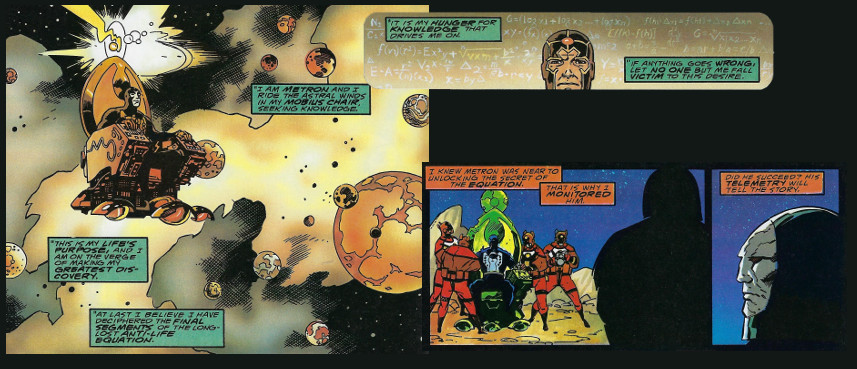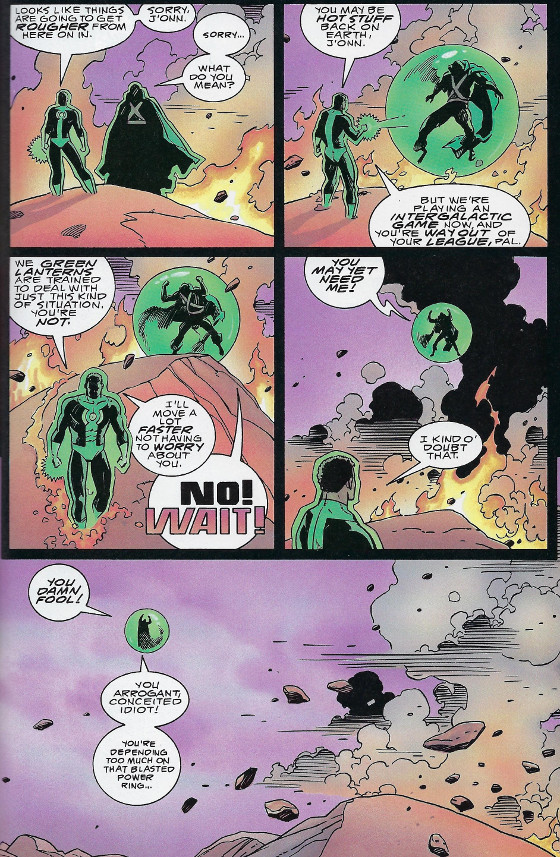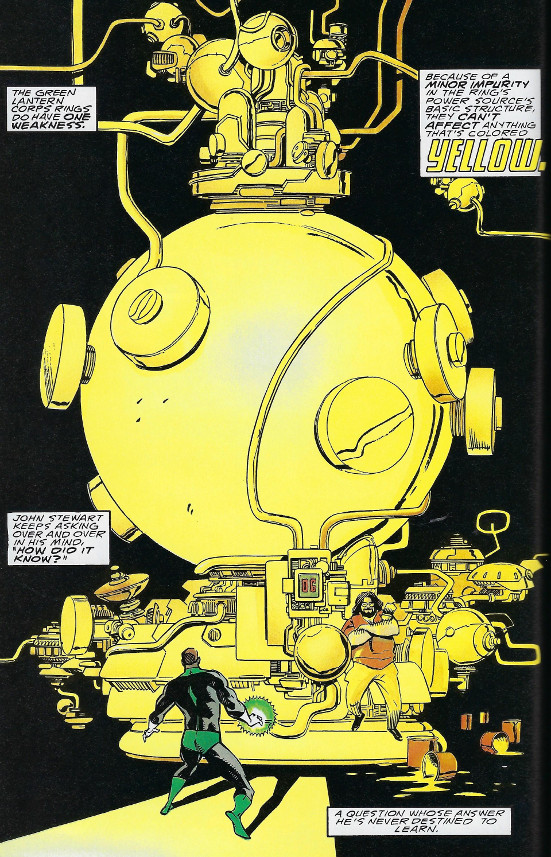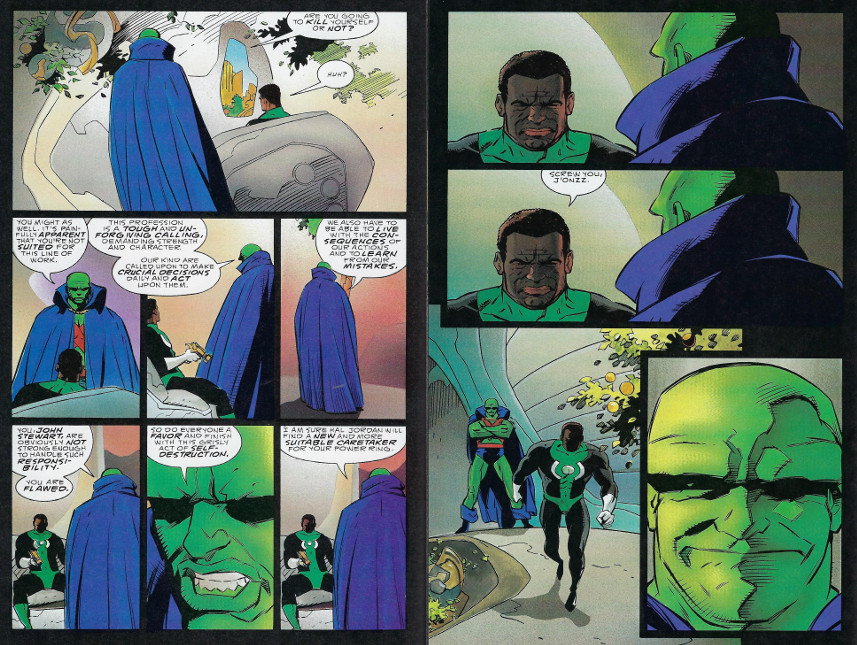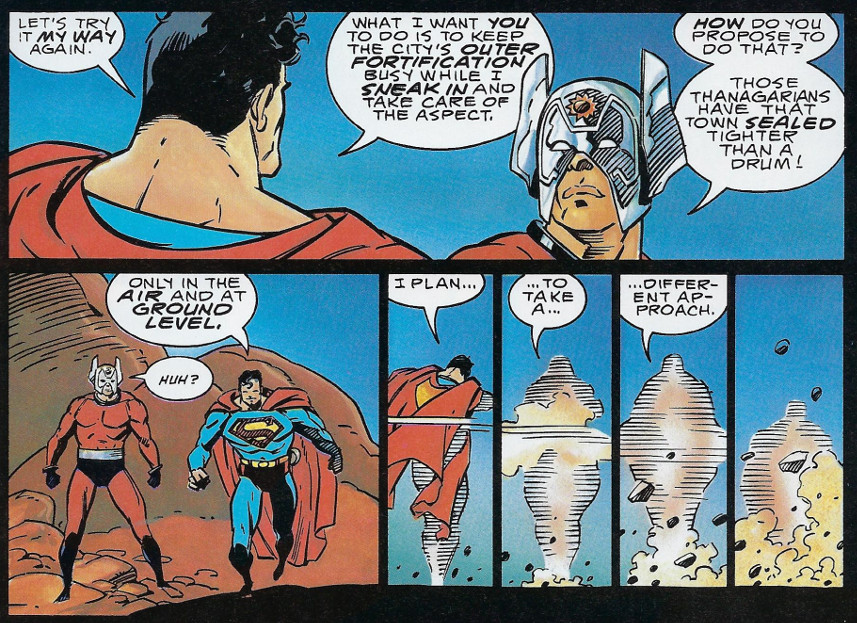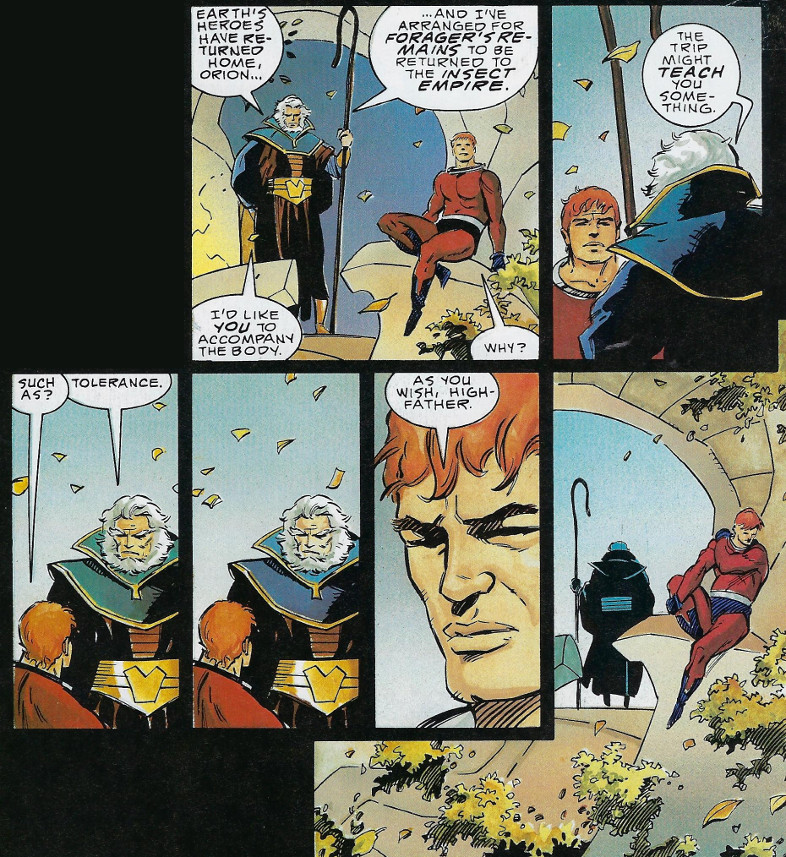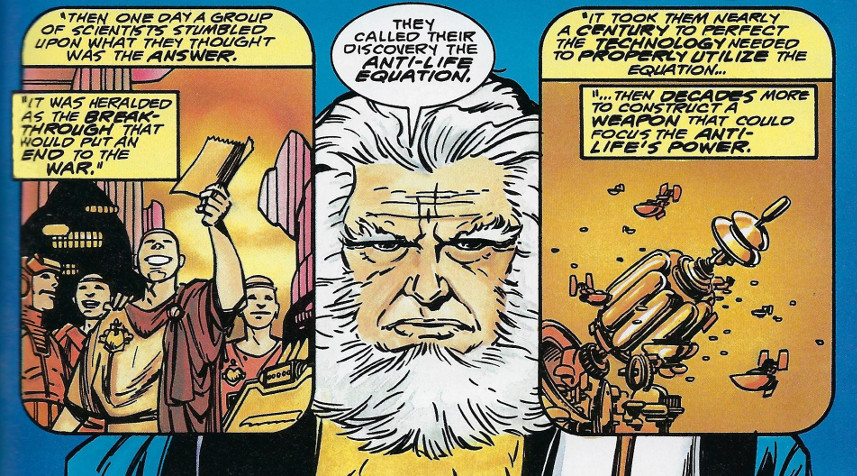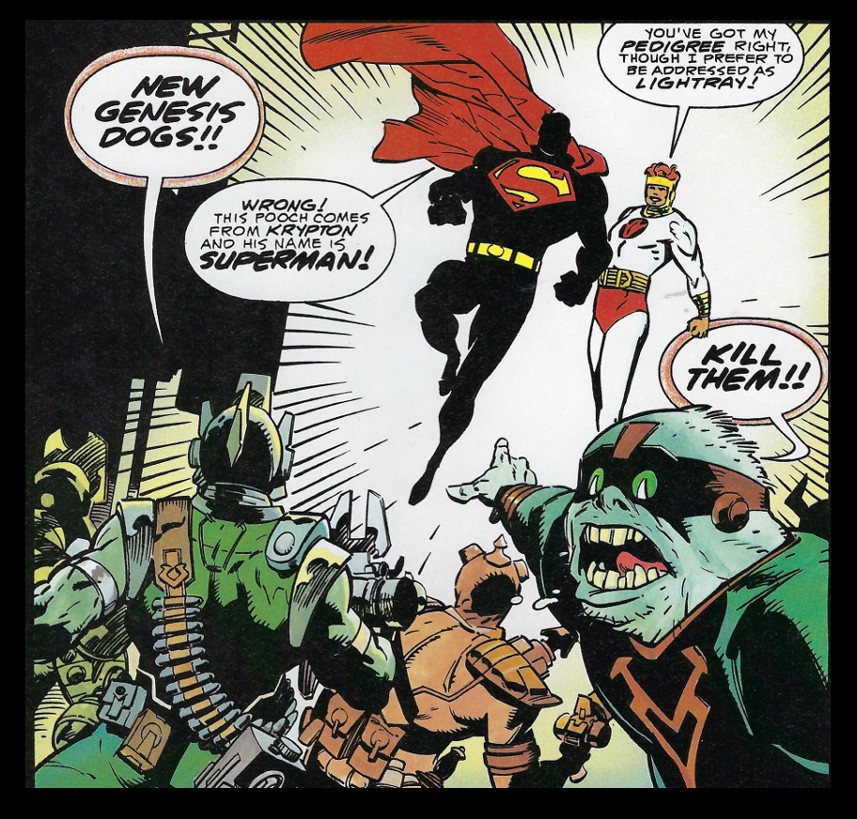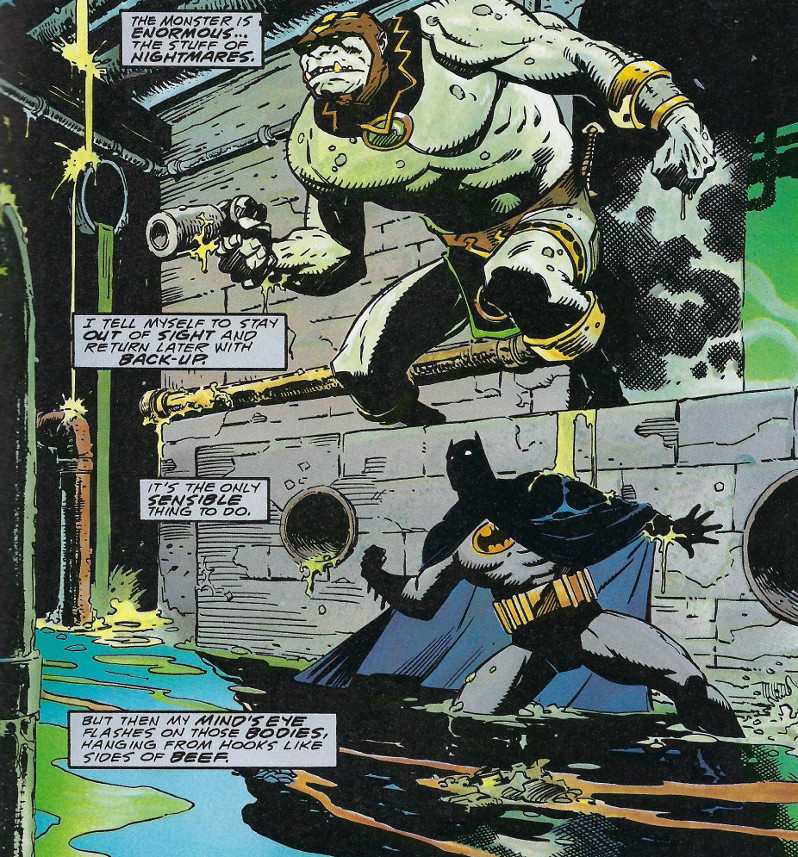A Turning Point
As discussed in the previous columns, Jack Kirby’s Fourth World has languished in mediocrity since the original excitement that surrounded its launch in the early 1970s. The only two exceptions were The Great Darkness Saga in the Legion of Super-Heroes and the X-Men/Teen Titan one-shot featuring the ‘resurrection’ of Dark Phoenix at the hands of Darkseid.
While both of these tales were exceptional in both art and story, both of them focused almost exclusively on Darkseid, whose villainy was more a vehicle for storytelling and rather than one for exploring his personality. He was used like a force of nature, a hurricane that descends upon the town and whose destructive force must be dealt with by our heroes. And the inhabitants of New Genesis were almost totally absent (excepting for a brief and even briefer appearance by Izaya and Orion at the end of the Great Darkness Saga). It was beginning to look like Kirby’s concepts and characters were merely stage dressing and props for other more interesting folk; want to accentuate Super-man’s heroism – have him deal with Darkseid.
The turning point came in 1988 with the publication of the four issue Cosmic Odyssey by the creative team of Jim Starlin, Mike Mignola, Carlos Garzon, Steve Oliff, and John Workman.
Starlin was already well known for his cosmic opera style with his handling of Thanos as the ultimate villain for Captain Marvel and Adam Warlock. In both of these story arcs, he was able to create highly textured heroes and villains and interesting events that caused their confrontation. Cosmic Odyssey finds Starlin once again at the top of his game, this time creating circumstances that bring the war between New Genesis and Apokolips to a new stage – an alliance between Darkseid and Izaya in the face of a greater evil.
This series is also notable three other things. First there is Starlin’s exploration of the human side of his characters using several interpersonal exchanges between pairs of characters. These interactions serve to soften and humanize what would otherwise be simply another ‘worlds about to end’ story. Second there is his attention to detail. Along the course of the story, Starlin add little bits of exposition that clarify inconsistent points that were either ignored or were exacerbated in previous New Gods stories. And third, Mignola’s art style is not only evocative and well-suited for the storyline but also works in iconographic elements similar to what Keith Giffen did for The Great Darkness Saga.
The plot is straightforward enough. In similar fashion as the X-Men/Teen Titans one shot, it starts with Metron’s insatiable thirst for knowledge and his attempt to breach what should not be breached – this time the secret of Anti-life.
Darkseid, who has long lusted after the secret, finds Metron and realizes that the end is nigh. Anti-life isn’t a thing but a sentient entity that seeks to invade our universe and destroy it. In breaching the barrier between the two dimensions, Metron has, inadvertently, allowed four Anti-life Aspects to follow him back. These Anti-life Aspects now threaten four star systems (Earth’s being one) with annihilation via doomsday devices, the destruction of any two ensuring that the parent entity can be freed.
Four teams are formed to capture the four aspects and destroy their doomsday devices before detonation: Batman and New Genesis’ Forager on Earth, New God Lightray and Teen Titan Starfire on Rann, Superman and Orion on Thanagar, and the Green Lantern John Stewart and the Martian Manhunter J’onn J’onzz on Xanshi. Darkseid and Izaya and Jason Blood/Etrigan stay behind on New Genesis, ready to implement a back-up plan should the dispatched teams look to fail.
While there is no doubt that the teams will somehow succeed and the universe will be saved, Starlin does a wonderful job of building the suspense and using the pairings to bring out aspects of the various personalities that would be lost otherwise.
The most poignant pairing come between John Stewart and J’onn J’onzz, who are dispatched to Xanshi, a world whose technology has perfected planetary geophysical control (weather and geology), which the aspect exploits in order to stop Stewart and J’onzz. Believing his power ring as the be-all-end-all, Stewart decides that J’onzz is a liability best left behind.
Unfortunately, the aspect knows full well about the weakness of the Green Lantern power rings to yellow and it paints the entire doomsday device with that color (note the smugness the aspect wears on its host body – an excellent example of Mignola’s style)
rendering Stewart completely helpless to prevent the death of millions as the Xanshi star system is destroyed. The interchange between J’onzz and Stewart, floating amidst the debris of what was once a flourishing world is particularly powerful.
Later on, after the danger has been averted, a morose and self-pitying Stewart contemplates suicide. J’onzz uses a little reverse psychology to put the chip back on Stewart’s shoulder.
The team-up between Superman and Orion on Thanagar is also interesting. Thanagar is the home of the powerful Hawk-Police, from whom Hawkman and Hawkwoman came. Since time is of the essence, Superman decides to get into the facility where aspect lies while Orion keeps the Hawkpolice occupied.
Orion is portrayed by Starlin as much more arrogant and insensitive than Kirby’s original concept. He doesn’t understand why Superman would forego a head-on approach and why the famous Kryptonian avoids the conflict that he craves.
Needless to say, Superman is eventually successful in capturing the aspect and destroying his doomsday machine. But success comes with a price, as Superman soon learns when he rejoins Orion above ground to find just how far the New God was willing to go to keep Thanagar’s citizens occupied.
The most interesting interactions center on Batman, whose brain and guile more than make up for his lack of cosmic superpowers. The tone is set early, when Darkseid introduces his plan for capturing the Anti-life aspects. Discussing his analysis in a condescending way, Darkseid makes sure that the ‘Earthers’ understand just how paltry their intellects are in comparison to his. Batman mocks this attitude when he receives his aspect-capture device.
But not knowing how a given scientific principle works doesn’t mean one is stupid, and, upon returning to Earth with Forager, Batman makes a phone call
This ‘friend’ turns out to be Doctor Fate, who uses his great magical abilities to thwart Darkseid’s hidden attempt to control the Anti-life entity for his own purposes. Marshalling his own power and those of Darseid, Etrigan, Izaya, and Orion, Doctor Fate creates a way of sealing the Anti-life entity away by destroying the conduit to its realm.
The universe is now safe from the Anti-life Entity’s invasion but the two remaining Aspects still pose a threat. Lightray and Starfire manage to succeed with little trouble thanks Starfire’s cleverness (in the one lackluster storyline). Batman and Forager have a much harder time and they only avert disaster thanks to Forager’s last-minute heroics that, unfortunately, take his life.
Bearing the news (along with the captured Aspect) back to New Genesis, Batman is enraged when Orion acts callously to Forager’s death and he reacts in one of the most emotionally-filled moments.
Orion’s prejudice towards Forager’s people and his humbling at Batman’s hands form the initial arc for the third New Gods series that follows. Indeed, the final page of Cosmic Odyssey sets the stage when Izaya and Orion talk.
The fine plot and character exploration and development are complemented by Starlin’s attention to the continuity details of the New God’s universe. He starts by shading the story of the Elder Gods demise and the birth of the New God’s by tying the former’s catastrophic end to their unlocking of the Anti-life secret.
Employing the Anti-life solution not only ended the Elder God’s existence, it severed both New Genesis and Apokolips, which rose from the ashes, from the rest of the Universe by a rift that can only be spanned by the Boom Tubes.
Finally, it is worth noting that much of Starlin’s story is complemented by Mignola’s artistic presentation. Early in Book 1, the reader is treated to a visual of Lightray and Superman
that not only clearly identifies Superman by isolating the ‘S’ on his chest but also emphasizes Lightray’s brightness. Later in the same book, Mignola gives us a stealthy Batman on the trail of a shock trooper from Apokolips.
Mignola is able to convey Batman’s shadowy presence and the overwhelming difference in sizes in one beautifully constructed frame. Mignola, employs a similar construction when Darkseid and Etrigan first confront the Anti-life Entity whose most imposing feature is his lack of features.
There you have it. The first serious and competent treatment of Kirby’s Fourth World since Kirby’s initial run in the early seventies. Cosmic Odyssey marks the turning point in the New Gods franchise within the DC Universe. Starling showed that with some thought these tales of good versus evil could have a new and interesting life.


